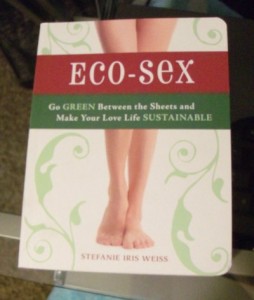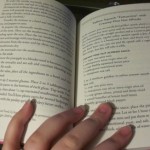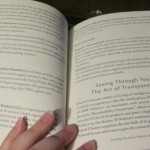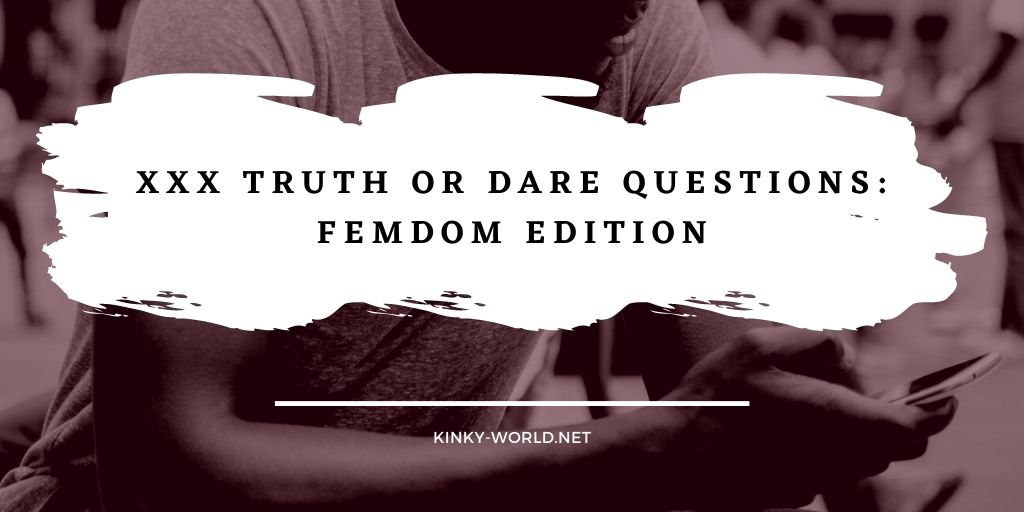
“Eco-Sex” is a book written by Stefanie Iris Weiss detailing different ways to make your sex life more eco-friendly. The book is published by 10 Speed Press. The book is a softcover book with black-and-white text-only pages on the inside. The book is 216 pages long and includes 11 chapters in 3 different parts. The book is pretty small in size at about five inches tall and four inches across. The book takes about four hours to read, and if you cover up the front-page title (which isn’t too bad either), then the book is completely discreet.
To be honest, I’ve never been much of an “eco” typa gal. I’ll do smaller parts, and I’ll help out where possible, but at the same time, it seems like it’s near-impossible to avoid doing *something* to hurt the environment – no matter where I turn. This book? This book scares me. It doesn’t want to motivate me to want to be safer for the environment with sex. It makes me want to crawl into a hole in my apartment and never, ever leave. My shampoo? Deadly. My birth control? Screwing up the fishes. My food? My clothes? Everything. If you interact with it on a daily basis, it probably is doing something wrong for this environment.
I’m having a hard time figuring out if this is because the book is written with scare-tactics in mind or whether all of our products really are all that horrible for the environment. I can believe that some of the stuff is – easily. However, the book makes it seem like there are really no good alternatives aside from really expensive organic stuff or making my own stuff. The book does a lot of brand-name product recommendations which, while helpful, also makes the book “age” faster as these companies may go out of business. I wish the book would have given more suggestions as to how to combat some of the environmental problems instead of just telling me what, exactly, is wrong with almost everything I use.
The book, while titled Eco-Sex, really doesn’t touch too much on sex. Out of the 11 chapters, only three of the chapters actually pertain to sex. Instead, the book tries to focus on everything that would have to do with sex. This includes gift-giving, dating, clothing to wear on the date, make-up, and lots of other little random things. While this is helpful if I was looking for information on everything to do with dating, I wasn’t; since the book is titled Eco-Sex, I was hoping for more information about sex. When something I’m concerned about (lubricant safety) is only given a small paragraph of information, I think it was time to cut back on some of the non-sex-related stuff.
The book does have a way of making me interested in reading more though. I really didn’t want to put this book down, and I ended up reading it in ten minute breaks between my classes. I’m not sure if this was the author’s writing style or if I wanted to know what else in my life was slowly killing me.

I asked the chemical engineer (who is probably biased in the opposite direction of an eco-writer) about the idea that all of the products are dangerous. Okay, “asked” is a light term. I came home and was about ready to trash everything in the house (and was in the process of throwing away all of our shampoo). He laughed at me and told me that, yes, all those things are probably carcinogenic like the book claims. He also then explained that because we don’t know what, exactly, causes cancer, almost everything we interact with could be carcinogenic, and the book was probably slanting statistics in its favor. (He did admit that our overly processed food probably is carcinogenic in some way though.)
As a Psychologist-in-training, I didn’t ike some of the stances the book took on sexual dysfunction. The book basically took the stance of “All sexual imbalances can be fixed through diet and exercise”, and that’s just not true. Yes, the majority of them can (we tend to freak out about sex in such large ways), but at the same time, the book doesn’t seem to ever take time to explain that in some cases, it really is a physical body problem that can not be fixed by diet or exercise.
In the sex toys chapter, the book does mention how horrible phthalates are. However, it doesn’t take much time to discuss alternatives to phthalate-ridden toys, and it doesn’t take any time to explain why stainless steel, glass, silicone, or any other body-safe options are probably better alternatives. It mentions a few sex toy shops (and includes some sex toy shopping tips from the founder of JimmyJane), but there isn’t any discussion of brand-name, body-safe toys. The creator of JimmyJane name-dropped a couple in his passages, but the author doesn’t write about any. I’d be curious about how stainless steel, glass, or silicone would break down in the environment and how that all would factor into the eco-friendly equation.
Along with all of this, I hope you are a crafty person. About twenty pages of this book is purely recipes for random things. This includes massage oil, body-safe foods, perfumes, body bath, and bath oils. These recipes can be really helpful if you’re looking for recipes, but if you’re looking for information, they just end up taking a lot of room in the book. However, they are a decent resource if you are looking for home-made solutions to some of the bad chemicals in other products.

Since I spent some much time talking about what the book doesn’t have, here’s what the book does have: Part 1 is all about dating and courtship. It includes a chapter about make-up, a chapter about how product ingredients are regulated, a chapter about clothes, a chapter about food, and a chapter about common gifts. (Diamonds, chocolate, gold, roses) Part 2 is about sex. It has a chapter about sexual dysfunctions and a chapter all about different birth control methods and how environmentally friendly they are. (Along with environmentally-friendly treatments for STDs) Part 3 is all about “other options” for the eco-friendly person. This section has a chapter on dating and where to find other eco-lovers, sex toys, how to make your bedroom environmentally-friendly, and how to eco-friendly parent your child.
Something I did really, really enjoy was the book’s “Think about having a child” decision. Sometimes I think that we are programmed to think that having children is the only point to get married, and some people just really aren’t “children” people, and a lot of people don’t realize that. The conclusion of the book actually talks about why having children is a bad idea for the environment including pushing the idea of adopting children. *That* is an idea I can get behind.
Regardless, I liked the book, but I feel like a lot of the book is more scare-tatic than usable information. There was also a large number of product recommendations which could make the book age faster than it needs to. I also feel like the book, while providing some good information about materials I’m now going to be avoiding, could have done a lot more sex-related information instead of being a general eco-book. It still is definitely worth the read though – especially if you want to know some of the dangers of some common materials used in household products.








